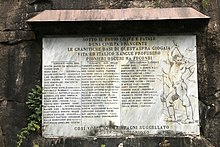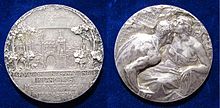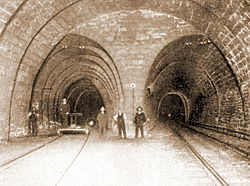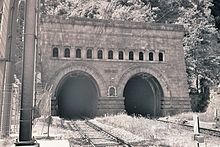|
Simplon Tunnel
The Simplon Tunnel (Simplontunnel, Traforo del Sempione or Galleria del Sempione) is a railway tunnel on the Simplon railway that connects Brig, Switzerland and Domodossola, Italy, through the Alps, providing a shortcut under the Simplon Pass route. It is straight except for short curves at either end.[1] It consists of two single-track tunnels built nearly 15 years apart. The first to be opened is 19,803 m (64,970 ft) long; the second is 19,824 m (65,039 ft) long, making it the longest railway tunnel in the world for most of the twentieth century, from 1906 until 1982, when the Daishimizu Tunnel opened. Culminating at a height of only 705 m (2,313 ft) above sea level, the Simplon Tunnel was also the lowest direct Alpine crossing for 110 years, until the opening of the Gotthard Base Tunnel in 2016. The tunnel has a maximum rock overlay of approximately 2,150 m (7,050 ft),[2] also a world record at the time. Temperatures up to 56 °C (133 °F) have been measured inside the tunnel.[3] Work on the first tube of the Simplon Tunnel commenced in 1898. The Italian king Victor Emmanuel III of Italy and the president of the Swiss Confederation (presiding the Federal Council of Switzerland for that year) Ludwig Forrer opened the tunnel at Brig on 19 May 1906.[4] The builders of the tunnel were Hermann Häustler and Hugo von Kager. Work on the second tube of the tunnel started in 1912 and it was opened in 1921. History Shortly after the opening of the first railway in Switzerland, each region began to favour a separate north–south link through the Alps towards Italy. Eastern Switzerland supported a line through the Splügen Pass or the Lukmanier Pass, Central Switzerland and Zürich favoured the Gotthard Pass and Western Switzerland supported the Simplon route. In 1871, the first line was completed through the Alps, connecting Italy and France with the Fréjus Rail Tunnel. The Compagnie de la Ligne d'Italie was founded in 1856 to build a connection between Romandy and Italy through the Canton of Valais and the Simplon. On 1 June 1874, it was taken over by the Simplon Company (French: Compagnie du Simplon, S), which was created to promote the project. This merged in 1881 with the company Western Swiss Railways (French: Chemins de Fer de la Suisse Occidentale, SO) to create the Western Switzerland–Simplon Company (French: Compagnie de la Suisse Occidentale et du Simplon, SOS). The French financiers of the SOS were able to secure finance for the tunnel in 1886. The company considered 31 proposals and selected one that involved the construction of a tunnel from Glis to Gondo, which would have been fully in Switzerland. From Gondo it would have continued on a ramp through the Divedro valley down to Domodossola. At a Swiss-Italian conference held in July 1889, it was agreed, however, to build a nearly 20-kilometre long (12 mi) base tunnel through the territory of both states. In order to secure credit for the tunnel, the SOS joined with the Jura–Bern–Luzern Railway to create the Jura–Simplon Railway (French: Compagnie du Jura–Simplon, SOS). The participation of the Swiss government led to the signing of a treaty with Italy on 25 November 1895 concerning the construction and operation of a railway through the Simplon from Brig to Domodossola by the Jura–Simplon Railway. The route of the tunnel was determined by military considerations so that the state border between the two countries was in the middle of the tunnel, allowing either country to block the tunnel in the event of war. On 1 May 1903, the Jura-Simplon Railway was nationalized and integrated into the network of the Swiss Federal Railways (SBB), which completed the construction of the tunnel. Construction The construction of the tunnel was carried out by the Hamburg engineering company Brandt & Brandau, of Karl Brandau and Alfred Brandt. On average, 3,000 people a day worked on the site. They were mostly Italians, who suffered under very poor working conditions: 67 workers were killed in accidents; many died later of diseases. During the work, there were strikes, which led to the intervention of vigilantes and the Swiss army. With up to 2,150 m (7,054 ft) of rock over the tunnel, temperatures of up to 42 °C (108 °F) were expected and a new building method was developed. In addition to the single-line main tunnel, a parallel tunnel was built, with the tunnel centres separated by 17 m (56 ft), through which pipes supplied fresh air to the builders in the main tunnel. It was envisaged that the parallel tunnel could be upgraded to a second running tunnel when required. The first Simplon Tunnel (19,803 m (64,970 ft) in length) was built almost straight, with only short curves at the two tunnel portals. On 24 February 1905, the two halves of the tunnel came together. They were out of alignment by only 202 mm (8 in) horizontally and 87 mm (3.4 in) vertically. Construction time was 7+1⁄2 years, rather than 5+1⁄2 years, due to problems such as water inflows and strikes.  Electrification and operation Operations commenced through the tunnel on 19 May 1906. Because of its length among other things, it has operated with electric traction rather than steam from the beginning. The official decision to use electricity was made only half a year before its opening by the then-still-new SBB. Brown, Boveri & Cie (BBC) were commissioned to carry out the electrification. They decided in 1904 to use the three-phase system being introduced in Italy, with a three-phase power supply of 3,400 volts at 15.8 Hz[5] using two overhead wires with the track acting as the third conductor. BBC had no electric locomotives and initially acquired three locomotives built for the Ferrovia della Valtellina—the owner of the lines from Colico to Chiavenna and Tirano, which had been electrified with this system in 1901 and 1902[5]—from their owner, the Rete Adriatica (Adriatic Network) railway company. These three locomotives (which became FS Class E.360) hauled all traffic through the tunnel until 1908. On 2 March 1930, the Simplon tunnel was converted to 15 kV, 16.7 Hz AC (single-phase). ExpansionBetween 1912 and 1921, the 19,823-metre long (65,036 ft) second tube, known as Simplon II, was built. On 7 January 1922 the northern section from the north portal to the 500-metre long (1,640 ft) passing loop in the middle of the tunnel was brought into operation, followed on 16 October 1922 by the southern section from the passing loop to the south portal. Second World WarDuring the Second World War, on both sides of the border, there were preparations for the possible detonation of the tunnels. In Italy, the German army planned, as part of its 1945 withdrawal, to blow up the tunnel, but was thwarted by Italian partisans with the help of two Swiss officials and Austrian deserters.
Present and futureCar-carrying shuttle trains There is a car-carrying shuttle between Brig and Iselle di Trasquera, which provides a 20-minute train journey as an alternative to driving over the Simplon Pass. The service began on 1 December 1959. As roads over the Simplon Pass steadily improved throughout the 1970s and 1980s the tunnel's shuttle schedule was cut back, then ended altogether on 3 January 1993. Almost twelve years later, on 12 December 2004, the car shuttle service began again and now runs about every 90 minutes. Piggyback transportIn the early 1990s, a project to implement the rolling highway system of piggyback operations for transalpine freight on the Lötschberg–Simplon axis was implemented. Such operations were possible under the previous profile of the Simplon Tunnel, but capacity would have been heavily restricted because its height was too low to carry trucks at the permitted maximum corner height of four metres (13 ft 1+1⁄2 in). The clearance in the tunnel was therefore increased by lowering the rail trackbed. This work began in 1995 and lasted eight years. At the same time, the tunnel vault was rehabilitated, while the drainage tunnel was rebuilt. A total of 200,000 m3 (260,000 cu yd) of rock was removed with pneumatic breakers. In addition, a new railway electrification system was installed using overhead electric rail instead of the tensioned cable normally used for overhead electrification so that the required 4.90-metre (16 ft 7⁄8 in) height clearance could be achieved. In the late 1980s, a one kilometre (0.62 mi) long overhead electric rail had been tested at 160 km/h (99 mph). Before this experiment, trains running under overhead electric rails in Switzerland had been limited to 110 km/h (68 mph) and internationally to 80 km/h (50 mph).[6] Restricted rail operations were maintained during the entire construction period. Expansion of access routesIn order to expand the Lötschberg-Simplon axis into a powerful transit axis, various extensions to the access lines (from Bern and Lausanne in the north and from Novara and Milan in the south) have been made in recent years and decades. The largest projects have dealt with the northern access from Basel-Bern via Lötschberg. Between 1976 and 2007 there were three major transformations. First, the remaining single-track line between Spiez and Brig was dualled. Later, adjustments were made to the tunnel profile for piggyback traffic; in places only widening one track was possible. Finally, the Lötschberg Base Tunnel partially opened in 2007, although the new tunnel still has a 21-kilometre (13 mile) single-track section; this was done in order to save costs for the construction of the longer Gotthard Base Tunnel, which was completed in 2016. Clearances were also raised for the piggyback traffic on the Italian side as well on the Simplon southern approach. Here, too, for financial reasons, at times only one line was cleared for the rolling highway. South of Domodossola, the single line to Novara via Lake Orta was electrified and modernized. The classic approach to the Simplon from Paris and Lausanne—less important for today's transit traffic—was upgraded in the context of a nationwide rail upgrading project, Rail 2000, between 1985 and 2004. Further adjustments are proposed. In November 2004, the 7-kilometre long (4.3 mi) new line between Salgesch and Leuk in the Rhone Valley was completed to replace the last single-track bottleneck on the route. Under the ZEB ("Future rail development projects") package, the maximum speed on the long straight sections of the Rhone valley lines will be increased from 160 to 200 km/h (99 to 124 mph). 2011 fireOn 9 June 2011, a 300 m (984 ft) section of the Simplon II tunnel's roof was seriously damaged when a northbound BLS freight train caught fire and stopped 3 km (1.9 mi) into the tunnel. The temperature exceeded 800 °C (1,470 °F) and took more than two weeks to cool back to normal. By agreement all repairs to the tunnels are the responsibility of the SBB, which expected to reopen the tunnel in December 2011. The other tunnel remained in service.[7] Repair work was completed in November 2011.[8] Facts and figures
In popular mediaIn the 1957 novel From Russia, with Love by Ian Fleming, protagonist James Bond fights his enemy, SMERSH agent Donovan Grant, eventually killing him, while passing through the Simplon Tunnel on the Orient Express. In Against the Day by Thomas Pynchon, Reef Traverse, one of the novel's characters, works on the construction of the Simplon Tunnel.[9] In the novel "The Couloir" by Richard Manichello, the Canton Valais is a major geographical setting for action and scenes. especially the Val de Bagnes. Brig and the Simplon Pass & Tunnel play an important role in the main plot, moving characters in and out of Western Swiss locations or over the Pennine Alps for various intrigues and subplots involving action that traverses Swiss and Italian story settings. Notes
References
External linksWikimedia Commons has media related to Simplon tunnel.
|
|||||||||||||||||||||||||||||||||||||||||||||||||||||||||||||||||||||||||||||||||||||||||||||||||||||||||||||||||||||||||||||||||||||||||||||||||||||||||||||||||||||||||||||||||||||||||||||||||||||||||||||||||||||||||||||||||||||||||||||||||||||||||||||||||||||||||||||||||||||||||||||||



